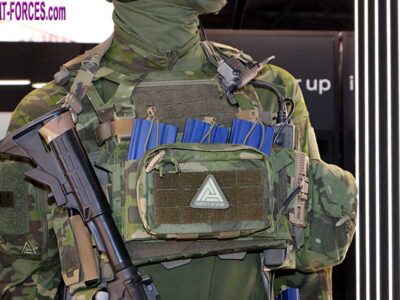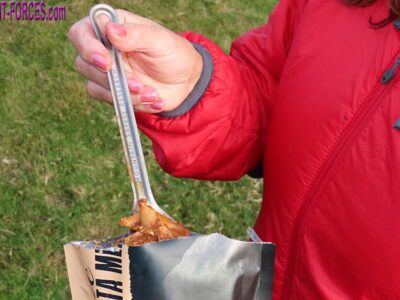
The first phase of the Baltics region JFE (Joint Forcible Entry) by US and UK troops on NATO Exercise SWIFT RESPONSE 24 involved 250 Paras, reports Bob Morrison.
~
As previously reported, UK and US Paratroopers were tasked with a Joint Forcible Entry and follow-on Rapid Air Land in Estonia commencing Friday 10th May. However a combination of high winds and low rain cloud over Nurmsi Drop Zone, not to mention peacetime safety constraints, forced a last minute change of plan. (See: SWIFT RESPONSE 24 Putting NATO Paratroopers to the Test).

Rather than parachuting into the airfield near the town of Paide, used these days by a sky sports club but formerly used as a 2,500m long grass strip airbase by Soviet Naval Aviation during the Cold War era, the American and British Paras de-planed at a commercial airport 90 kilometres northwest. ‘Plan B’ to beat the weather was for them to fly forward by CH-47 Chinook helicopters instead, supported by AH-64E Apaches and AW159 Wildcats flying in from Sweden, to engage mostly Reservist defenders from the Estonian Defence Forces and the volunteer Estonian Defence League. However as the low cloud, driving rain and very limited visibility were deemed unsafe for the peacetime use of transport helicopters, the Paras were conveyed to the start line by wheeled transport (did someone say no plan escapes first contact with Mother Nature?) to allow them to commence the scheduled assault on the defensive positions in the forest immediately to the east of the airstrip.

After the first objective has been seized by the NATO Paratroopers, from the US 82nd Airborne Division and the UK 3rd Battalion of the Parachute Regiment, they were transported back to their departure airfield in the hope that the weather conditions would have improved sufficiently by next morning to allow the rescheduled drop to go ahead. By the time I returned to the drop zone (DZ) for JOINT-FORCES very early next day, a few minutes ahead of 16 Medical Regiment who were providing DZ coverage, the cloud had lifted… though if anything the speed of the bitter wind gusts from the Arctic North seemed even higher. The sky may have been azure blue as a weather front blew through, but one did not need a Kestrel wind meter to realise that conditions for static line parachuting were borderline at best.


Just before the appointed hour, with the met forecast suggesting wind strength was only likely to increase rather than drop later in the morning, the team of three US DZ safety personnel along with the RAF DZ Safety Officer made final checks on wind speed and direction as the lead US Air Force C-17 Globemaster approached from a north-westerly direction. Three C-17s flying in line, at precise five minute intervals, were transporting a total of 250 Paras in pairs of sticks of 41 to 43 with the intent being for each aircraft to make two live passes roughly northwest to southeast while flying in an anticlockwise racetrack pattern. At the two minute marker the lead aircraft called ahead for wind direction and speed and after a final check the Safety NCO called both out and announced “No Drop!” over the airwaves. The Globemaster passed overhead at 1,000 feet with both jump doors closed and entered the racetrack.


[© Bob Morrison]

Precisely five minutes behind, to allow medics on standby into the drop zone to reach any heavy landing casualties from the previous pass, the second aircraft crew flew over the two minute marker, called ahead for wind details, and again “No Drop!” was called by the NCO. However five minutes after this the speed of the gusts had dropped just within limits and she announced to the crew of the third C-17 that they were clear to make the initial drop. The first stick of around 42 Paras swiftly exited this third aircraft but it would take ten more C-17 passes for the five remaining sticks to safely jump during drops in wind gust speed. Of course had this been an operational parachute drop the safety limits would not have had such an impact and the aircraft would not have needed to go around so many times, plus all three aircraft would have flown in close staggered formation and at lower height to allow all Paras to jump in a single pass.



Although this Baltics phase of SWIFT RESPONSE 2024 was UK-led, with 16 Air Assault Brigade Combat Team (16AA BCT) being the primary formation, the Paras only jumped from American C-17 Globemasters. RAF C-17 and the pair of RAF A400M Atlas transport aircraft participating on the Estonian leg of the exercise, as we will see in my next article, played no part in the parachuting. When earlier this year we were informed of the potential date for the main drop it was suggested that almost one third of the 22-strong RAF Atlas fleet and potentially two battalions of UK Paras might take part in parachute operations, but not only is UK tactical air transport capability currently stretched so thin that only a single RAF Atlas was said to be available for the 80th Anniversary D-Day celebrations in early June but it is our understanding that it is still likely to be quite some time before sufficient aircraft, aircrews and personnel are qualified for a peacetime battalion strength parachute drops by day or night.


[© Bob Morrison]


[images © Bob Morrison unless otherwise credited]
~
Footnote: SWIFT RESPONSE 24 began with six near-simultaneous joint forcible entries (JFE) into Estonia, Moldova, North Macedonia, Poland, Romania, and Sweden. Although there have been larger individual exercise JFE parachute drops by US Airborne Forces with NATO Allies (most notably the US-led JOINT WARRIOR 96 over Fort Bragg with the UK’s 5 Airborne Brigade and the Polish-led ANAKONDA 16 multinational mass drop over Torun) the geographical spread, complexity and total number of participants put SR24 in a class of its own.
- Continued here:- SR24 UK Rapid Air Land in the Baltics






















Pingback : SR24 UK Rapid Air Land in the Baltics | Joint Forces News
Pingback : LOWA BREACHER GTX MID in Brown | Joint Forces News